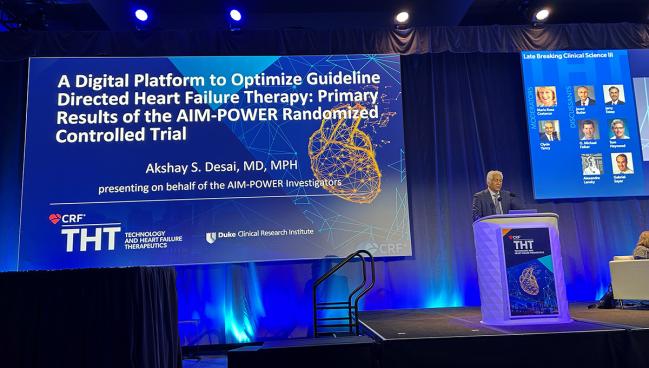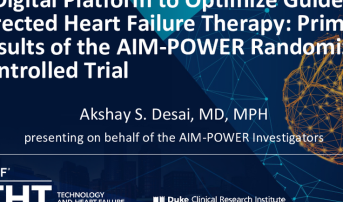AIM-POWER: Remote, App-Based Intervention Boosts GDMT Use in HFrEF
Using the BiovitalsHF software to personalize recommendations got more patients on all four pillars of therapy.

BOSTON, MA—A digital intervention helps physicians make personalized treatment recommendations for patients with heart failure with reduced ejection fraction (HFrEF) that can enhance uptake of guideline-directed medical therapy (GDMT), the AIM-POWER trial shows.
Compared with usual care, use of the BiovitalsHF platform (Biofourmis) provided a greater increase in an HF optimal therapy score at 90 days and boosted the proportions of patients who were taking all four components of foundational GDMT and on at least 50% of the target doses.
This was done without an increase in overall adverse events, although there were numerically more hyperkalemia events (four vs one) and episodes of kidney injury (two vs zero), Akshay Desai, MD (Brigham and Women’s Hospital, Boston, MA), reported here at THT 2025.
“These data support the potential for digital therapeutic interventions to be a scalable solution [for] implementation gaps in heart failure with reduced ejection fraction therapy,” Desai said during his presentation.
Aiming to Fill the Gap
This is a major need, with prior research indicating that fewer than one-third of US patients with HFrEF receive foundational, four-pillar treatment with a beta-blocker, a renin-angiotensin-system (RAS) blocker or angiotensin receptor-neprilysin inhibitor (ARNI), a mineralocorticoid receptor antagonist (MRA), and a sodium-glucose cotransporter 2 (SGLT2) inhibitor. Even when patients are started on these medications, they’re rarely titrated to target doses, Desai said.
Multiple efforts have been made to address this issue. Among them are digital applications that provide automated and personalized recommendations to physicians, Desai noted. “You can think of these as nudges that are delivered at the elbow of the physician to [improve] prescription of guideline-directed medical therapy in the clinic.”
He and his colleagues evaluated the BiovitalsHF platform, which relies on information collected at home by the patient, including blood pressure, body weight, and vital signs like heart rate and other respiratory signs from a wearable patch, as well as laboratory measurements prescribed by the treating physician. This information is sent to a mobile app and uploaded to a cloud-based server, where software incorporating artificial intelligence (AI) analyzes it and provides treatment recommendations to physicians. Doctors then decide which actions to pass on to patients through the app.
This process was compared with usual care in AIM-POWER, which included patients with chronic HFrEF (LVEF < 40%) who were not on optimal medical therapy, defined as being on at least one core medication at less than 50% of the target dose. After a period of becoming accustomed to the software, 122 patients (mean age 61 years; 69% men) were randomized to management via the app or usual care for 90 days and then followed for an additional 90 days free from the intervention.
The primary endpoint was the between-group difference in the change from baseline to 90 days in an HF optimal therapy score derived by looking at whether patients were getting certain medications and at the dosing. The change was greater in the intervention versus the control arm (mean 1.72 vs 0.44 points; P < 0.001).
Greater improvements in both prescriptions and intensity of treatment were seen across each of the four classes of GDMT.
In addition, patients managed with the digital intervention were more likely to reach at least 50% of the target doses (HR 6.84; P = 0.01) and to get on quadruple therapy (HR 2.44; P = 0.003). Roughly 60% of patients in the intervention arm were taking all four classes at the end of the study, compared with about 35% in the control arm.
The intervention was safe overall, Desai reported, with 21 total adverse events in patients managed with the BiovitalsHF system and 18 in those who received usual care. There were two cardiovascular deaths and one stroke (all in the control arm). One case of syncope occurred in the intervention group, along with slightly higher numbers of serious hyperkalemia and acute kidney injury.
The investigators also did an analysis of a win-ratio composite endpoint incorporating CV death, HF hospitalization, improvement in HF optimal therapy score, improvement in Kansas City Cardiomyopathy Questionnaire score, and reduction in NT-proBNP. This favored the intervention, with a win ratio of 3.4 (95% CI 3.1-3.7).
Questions About Implementation
There’s a lot of interest in how the uptitration of GDMT can be optimized and many strategies have been tried, Heart Failure Society of America President G. Michael Felker, MD (Duke University, Durham, NC), commented to TCTMD.
“One of the things I’m struck by is that the physician is sometimes the weak link in the chain because they’re sort of inclined to be like, ‘Well, maybe we’ll just have [the patient] come back in a few weeks and we’ll see how they’re doing,’” he said. He added that in general, physicians are focused on avoiding harm and thus wary of algorithms that tend to be more aggressive about uptitration.
Felker said, however, “I think this rapid intensification, which may or may not have the actual clinicians in the loop completely, is actually the key to doing better.”
There are going to be a lot of technologies introduced to get at this problem, he said. “This is the kind of thing where technology platforms are useful, with all the potential caveats around access and how different patient populations are easier and/or harder to access with different kinds of technology. . . . I’m not surprised this one showed some promise, and I think many others will too.”
During a panel discussion following Desai’s presentation, Clyde Yancy, MD (Northwestern Feinberg School of Medicine, Chicago, IL), said that there’s a question about how to calibrate these types of approaches at the individual level. “Because we have certain patients that will have intolerabilities, have relative contraindications. There’s always a cost component. There’s a digital literacy component,” he said. “So, it offers a lot of opportunity, but it raises a lot of questions.”
Desai noted that this particular intervention relied on input from the clinician, who decided which recommendations to send to patients. “Hopefully, there’s some integration of knowledge of the patient, their capacity to make changes, their history of adverse events, and [their] experience with medical therapy that informs some of the decision-making for the individual patient,” he said.
Whether future iterations of this approach can take some of the clinician’s involvement out of the process to improve workflow is an open question, Desai indicated. As for who will make the decisions in that scenario, he said, “The notion is that, at scale, this becomes whoever the provider is doing longitudinal disease management at the institution who would be typically implementing guideline-directed medical therapy.”
That might involve pharmacists, nurses, or navigators, the panelists suggested. “I think that is the path forward, particularly at scale, because there’s certainly not enough of us to do this and . . . we don’t always do it well,” said Desai.
Todd Neale is the Associate News Editor for TCTMD and a Senior Medical Journalist. He got his start in journalism at …
Read Full BioSources
Desai AS. A digital platform to optimize guideline directed heart failure therapy: primary results of the AIM-POWER randomized controlled trial. Presented at: THT 2025. February 12, 2025. Boston, MA.
Disclosures
- Desai reports receiving institutional research grant support from Abbott, Alnylam, AstraZeneca, Bayer, Novartis, and Pfizer and personal consulting fees from Abbott, Alnylam, AstraZeneca, Avidity Biopharma, Axon Therapeutics, Bayer, Biofourmis, Boston Scientific, Endotronix, GlaxoSmithKline, Medpace, Medtronic, Merck, NewAmsterdam Pharma, Novartis, Parexel, Porter Health, Regeneron, River2Renal, Roche, scPharmaceuticals, Veristat, Verily, and Zydus.






Comments